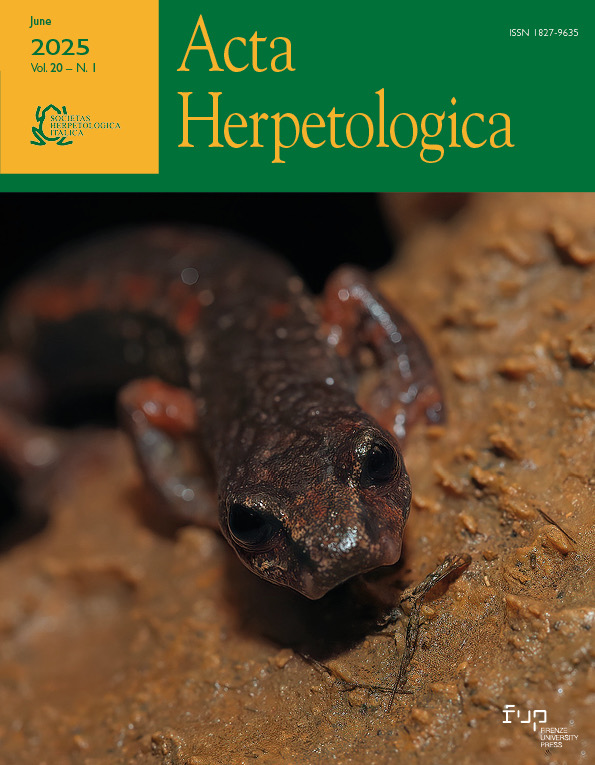Land leech (Haemadipsa zeylanica) parasitizing Indosylvirana indica (Indian golden-backed frog) in Agumbe, India
Published 2025-05-16
Keywords
- Anura,
- Brown leech,
- Endemic,
- Haemadipsidae,
- Jawed land leech
- predation,
- Ranidae,
- type leech (Cochin) ...More
How to Cite
Copyright (c) 2025 Mahesh Bilaskar, Surendra Walke

This work is licensed under a Creative Commons Attribution 4.0 International License.
Abstract
This study documents the first recorded instance of ectoparasitism of the Indian golden-backed frog (Indosylvirana indica) by the land leech (Haemadipsa zeylanica) in Agumbe, India. Observation indicates that a specimen of I. indica was infested by H. zeylanica, with the leech attached to the frog’s tympanum. While leeches are known ectoparasites of amphibians and can disrupt their health by serving as vectors for pathogens, this association had not been previously documented for I. indica. Our findings highlight the need for further research into leech-anuran interactions to better understand ecological dynamics and their implications on amphibian health.
References
- Ben Ahmed, R., Romdhane, Y., Tekaya, S. (2015): Checklist and distribution of marine and freshwater leeches (Annelida, Clitellata, Hirudinea) in Tunisia with identification key. Ecol. Monogr. 2: 3-19. DOI: https://doi.org/10.37828/em.2015.2.1
- Berven, K.A., Boltz, R.S. (2001): Interactive effects of leech (Desserobdella picta) infection on wood frog (Rana sylvatica) tadpole fitness traits. Copeia 4: 907-915. DOI: https://doi.org/10.1643/0045-8511(2001)001[0907:IEOLDP]2.0.CO;2
- Biju, S.D., Garg, S., Mahony, S., Wijayathilaka, N., Senevirathne, G., Meegaskumbura, M. (2014): DNA barcoding, phylogeny and systematics of Golden-backed frogs (Hylarana, Ranidae) of the Western Ghats-Sri Lanka biodiversity hotspot, with the description of seven new species. Contr. Zool. 83: 269-335. DOI: https://doi.org/10.1163/18759866-08304004
- Burgin, S., Schell, C.B. (2005): Frog eggs: Unique food source for leech Bassianobdella fusca. Acta Zool. Sin. 51: 349-353.
- Chandra, M. (1982): A Check-List of Leeches of India. Rec. Zool. Surv. India 80: 265-290. DOI: https://doi.org/10.26515/rzsi/v80/i3-4/1982/161193
- Delima-Baron, E.M., Tagoon, M.D., Bosabica, Z.C., Vitor-Maluya, K.C. (2024): First account of a leech attached to Philautus acutirostris (Peters, 1867) in southern Mindanao, Philippines. Herpetol. Notes 17: 499-501.
- Elliot, J.M., Dobson, M. (2015): Freshwater leeches of Britain and Ireland: keys to the Hirudinea and a review of their ecology. The Freshwater Biological Association, Ambleside.
- Fogden, S. C. L., Proctor, J. (1985): Notes on the Feeding of Land Leeches (Haemadipsa zeylanica Moore and H. picta Moore) in Gunung Mulu National Park, Sarawak. Biotropica 17: 172-174. DOI: https://doi.org/10.2307/2388511
- Frost, D.R. (2019): “Indosylvirana indica (Biju, Garg, Mahony, Wijayathilaka, Senevirathne, and Meegaskumbura, 2014)”: Amphibian Species of the World: An Online Reference. Version 6.0. American Museum of Natural History.
- Jiménez Sánchez, M.S. (1997): Contribución al conocimiento de la parasitofauna de la Rana perezi Seoane, 1885 (Amphibia: Ranidae) de la provincia de Ávila. Parasitología. Universidad Complutense de Madrid- Facultad de Farmacia, Madrid.
- Kalki, Y., Huizinga, R., Weiss, M. (2020): Mosquitoes (Uranotaenia sp.) biting an Indian Golden-backed Frog (Indosylvirana indica). Reptil. Amphib. 27: 454-455. DOI: https://doi.org/10.17161/randa.v27i3.14878
- Lunghi, E., Ficetola, G.F., Mulargia, M., Cogoni, R., Veith, M., Corti, C., Manenti, R. (2018): Batracobdella leeches, environmental features and Hydromantes salamanders.vInt. J. Parasitol-Par. 7: 48-53. DOI: https://doi.org/10.1016/j.ijppaw.2018.01.003
- Mandal, C.K. (2004): Checklist of the Hirudinea (Leeches) of India. Rec. Zool. Surv. India 102: 41-46. DOI: https://doi.org/10.26515/rzsi/v102/i1-2/2004/159525
- Manenti, R., Lunghi, E., Canedoli, C., Bonaccorsi, M., Ficetola, G.F. (2016): Parasitism of the leech, Batracobdella algira (Moquin-Tandon, 1846), on Sardinian cave salamanders (genus Hydromantes) (Caudata: plethodontidae). Herpetozoa 29: 27-35.
- Merilä, J., Sterner, M. (2002): Medicinal leeches (Hirudo medicinalis) attacking and killing adult amphibians. Ann. Zool. Fenn. 34: 343-346.
- Rocha, R., Borda, E., Andreone, F., Rosa, G.M. (2012): First reports of leech parasitism in Malagasy anurans. Comp. Parasitol. 79: 352-356. DOI: https://doi.org/10.1654/4546.1
- Zachariah, A., Cyriac, V.P., Chandramohan, B., Ansil, B.R., Matthew, J.K., Raju, D.V. Abraham, R.K. (2016): Two new species of Raorchestes (Anura: Rhacophoridae) from the Silent Valley National Park in the Nilgiri hills of the Western Ghats, India. Salamandra 52: 63-76.





